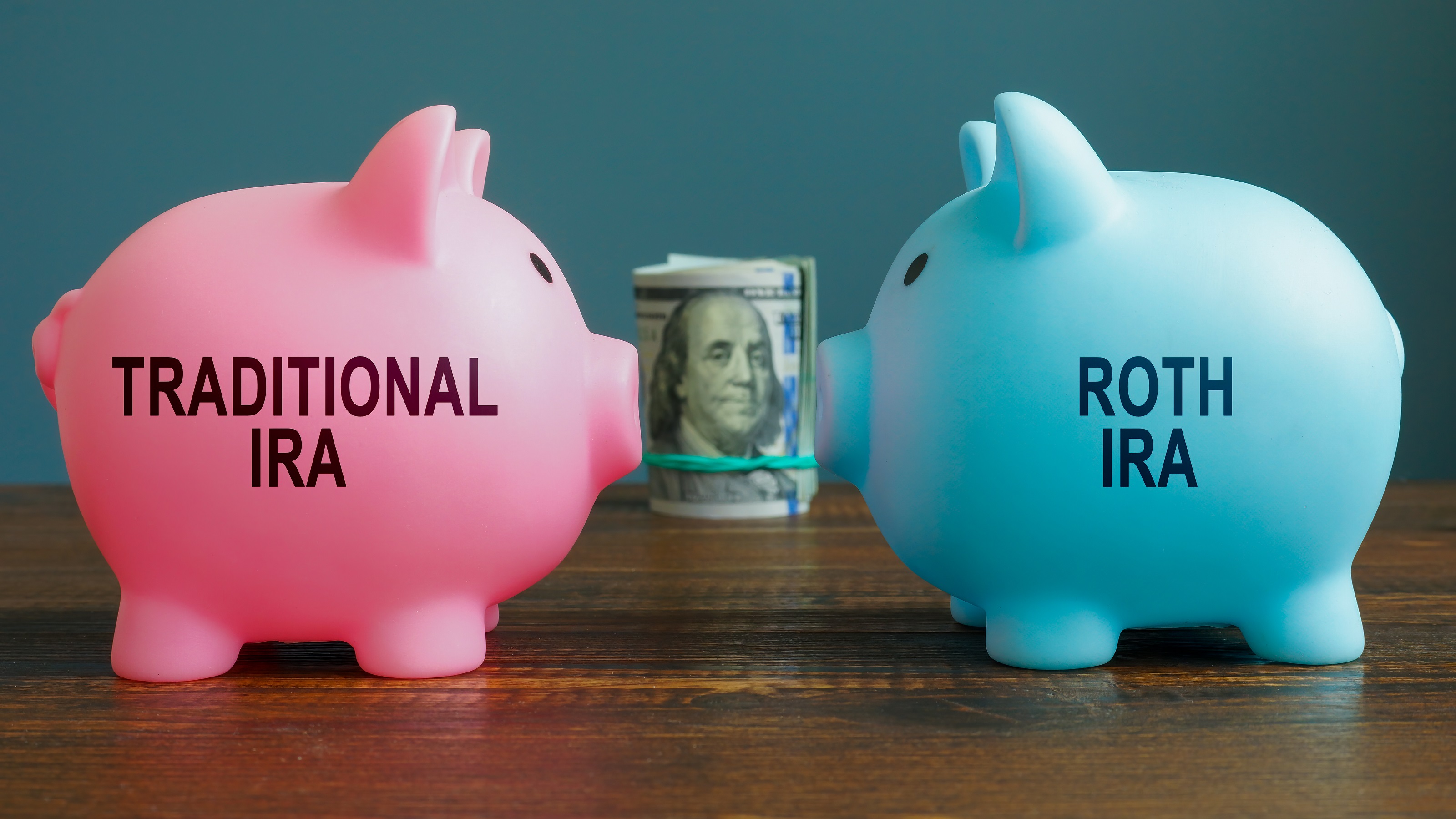Roth IRA vs. Traditional IRA: Which is Better?
When deciding between a Roth IRA vs. traditional IRA, remember that both types of accounts are great tools for building a nest egg — if you know how to use them.


Deciding between a Roth IRA vs. a traditional IRA boils down to taxes. Do you want to reap the tax advantages of traditional IRAs up front, with contributions taken out of your paycheck for a lower tax burden in the current year? Or would you prefer to pay those taxes now and enjoy tax-advantaged withdrawals in retirement with a Roth IRA?
Americans believe they'll need $1.26 million to retire comfortably, according to findings from Northwestern Mutual’s 2025 Planning & Progress Study, or about 80% of their pre-retirement income. That makes an individual retirement account (IRA) an excellent tool for building a robust nest egg.
If you make ongoing contributions and diversify your investments, you could build an IRA portfolio worth hundreds or thousands of dollars. In fact, the average IRA balance for all age groups at the end of the third quarter of 2024 was $129,200. The question is not so much whether you should have an IRA but which kind you should use: Roth or Traditional?
From just $107.88 $24.99 for Kiplinger Personal Finance
Become a smarter, better informed investor. Subscribe from just $107.88 $24.99, plus get up to 4 Special Issues

Sign up for Kiplinger’s Free Newsletters
Profit and prosper with the best of expert advice on investing, taxes, retirement, personal finance and more - straight to your e-mail.
Profit and prosper with the best of expert advice - straight to your e-mail.
Here are some key factors to consider.
Roth IRA vs. Traditional IRA: What's similar?
Contribution limits. Contribution limits for 2025 are the same as they were in 2024 — $7,000 for both traditional and Roth IRAs. If you are 50 or older, you can add an extra $1,000 catch-up contribution for a total contribution limit of $8,000.
Contribution deadlines. For any given tax year, you generally have until the tax deadline in the following year to contribute to either a traditional or Roth IRA. So, for the 2026 tax year (when you file your 2025 taxes), most people have up until Tax Day 2026. There are no age limitations.
Earned income requirement. The contribution amount must come from your earned income, such as wages, salary, commissions, tips, bonuses or profits from self-employment. This does not include earnings from rental income, annuities, pensions or deferred compensation.
Spousal IRA rules. If one spouse does not work, the other spouse’s earned income can qualify them to open a separate IRA in their own name, known as a “spousal IRA.” The other spouse's earned income can be used so long as the couple files a joint federal tax return.
Now, let’s take a look at some of the main differences. They include whether you can deduct a contribution and if distributions are tax-free.
Different tax deduction rules
A Roth IRA allows you to make after-tax contributions, and your contributions grow tax-free. However, you receive no current-year tax benefits with a Roth.
With a Traditional IRA, donations are tax-deductible in retirement. That's not the case with a Roth.
On the other hand, a Traditional IRA may allow you to make pre-tax contributions, which grow tax-deferred. You also receive immediate tax benefits, subject to income limitations for participants in employer-sponsored plans.
Suppose you file as single and are age 55. You have been falling short of your retirement goals, so you make a maximum contribution to your IRA account. This includes $7,000 plus the $1,000 catch-up contribution for those over age 50, for a total of $8,000. Moreover, you are in the 24% federal tax bracket (which is based on your current income level). This means your deduction will be 24% multiplied by $8,000, or $1,920. You may also be eligible for a state tax deduction.
But there is a wrinkle. You may not be able to take the full deduction for your traditional IRA contribution if you or your spouse is eligible for an employer-sponsored retirement plan like a 401(k) or 403(b). The contribution amount will be phased out based on your modified adjusted gross income (MAGI). Each year, the IRS sets the limits.
Different taxes on distributions
For traditional IRAs, the IRS imposes restrictions on the distribution of funds from your account. If you make a withdrawal before reaching 59-½, you will be subject to income taxes and a 10% penalty. There are some exceptions to the penalty, such as for total and permanent disability, $10,000 for a qualified first-time home purchase and some unreimbursed medical expenses.
The penalty also does not apply when you reach 59-½. However, you are still subject to income taxes.
For a Roth IRA, there are fewer restrictions on withdrawals. At any time, you can take out your contributions tax-free and without a penalty. But when it comes to earnings in the account, you need to be 59-½ and have held the Roth IRA for at least five years for this to apply.
For example, you are single, age 58, and in the 24% tax bracket. You established a Roth IRA two years ago and have contributed $20,000. The earnings on the account are $5,000. You can withdraw the $20,000 without paying taxes or a penalty. But this is not the case for your earnings. You will pay $1,200 in taxes, or 24% multiplied by $5,000, and a $500 penalty (10% multiplied by $5,000).
There's also a crucial difference in how you may take distributions later in life. A traditional IRA requires you to take required minimum distributions (RMDs) at age 73 (or 75 in 2033). But you will not have to take RMDs for your Roth IRA at any set age. You may even opt to forgo distributions while alive to pass your Roth IRA down to your heirs.
What about IRAs and planning your estate?
Estate planning is another important consideration when deciding which type of IRA to choose. As mentioned above, Roth IRAs do not force you to take required minimum distributions (RMDs) while you are alive, so you may bequeath the account to your heirs. However, they will be subject to withdrawal requirements. Your heirs, except your spouse, must either take out all the funds or set up an inherited Roth IRA, which includes RMDs. If the account was inherited after 2019, these distributions generally are for a 10-year period. As long as the Roth IRA has existed for five years, the amounts are tax-free.
Another benefit of a Roth IRA is that it can force you to set aside more money for your retirement. How so? With a traditional IRA, it’s common for people to spend their tax refund soon after they receive it. For example, in 2024, many people spent their tax refunds on necessities, with about 48% saving their money, 34% paying down debt, and 30% using their tax refund for everyday expenses. Some allocated funds for home improvements and major purchases, but only a small percentage indulged in luxuries, according to Statista.
With a Roth IRA, the tax savings are not available until later, when you make withdrawals, so you automatically have that money later rather than sooner.
Splitting or converting an IRA
The decision regarding which IRA account to invest in is certainly complicated. After all, the evaluation is about forecasting the future – and this usually needs to be done over the course of many years. This is why splitting your contributions between a traditional and a Roth IRA may be better.
However, for this strategy to work, you must be eligible for the Roth IRA. For 2025, you can contribute the maximum limit if you are single and your modified adjusted gross income (MAGI) is less than $150,000 (up from $146,000 in 2024), or less than $236,000 (versus $230,000 in 2024) if married and filing jointly. This is gradually phased out until this amount reaches $165,000 for single fliers, or $246,000 if married and filing jointly in 2025.
If your income is over the maximum amount, there are measures you can take to lower your MAGI to qualify for a Roth IRA. For example, you may contribute to a health savings account (HSA) to lower your MAGI.
If you qualify, you can benefit from both a traditional and Roth IRA. Then, as your circumstances change over time, you can adjust how you make your allocations. Remember, too, that it is possible to convert a traditional IRA to a Roth IRA. However, carefully weigh the pros and cons of converting and consult a financial planner or qualified tax adviser before acting.
So, should you use a Roth or traditional IRA?
Evaluating whether to select a traditional IRA or a Roth IRA comes down to thinking about different scenarios. For example, if you are currently in your peak earning years and believe your income will be lower in retirement, then you may want to select a traditional IRA. The reason is that your distributions will be taxed at a lower rate.
On the other hand, if you are young and just starting a career but you expect to be in a higher tax bracket when you begin taking withdrawals, then a Roth could be a better option. That's because the tax savings from the deductions of the traditional IRA might not be as attractive.
Want more guidance on retirement savings? Sign up for Kiplinger's six-week series, Invest for Retirement.
Related Content
Profit and prosper with the best of Kiplinger's advice on investing, taxes, retirement, personal finance and much more. Delivered daily. Enter your email in the box and click Sign Me Up.

Tom Taulli has been developing software since the 1980s when he was in high school. He sold his applications to a variety of publications. In college, he started his first company, which focused on the development of e-learning systems. He would go on to create other companies as well, including Hypermart.net that was sold to InfoSpace in 1996. Along the way, Tom has written columns for online publications such as Bloomberg, Forbes, Barron's and Kiplinger. He has also written a variety of books, including Artificial Intelligence Basics: A Non-Technical Introduction. He can be reached on Twitter at @ttaulli.
-
 Should You Renew Your CD?
Should You Renew Your CD?With rate cuts impacting earnings, we examine if now is a wise time to renew CDs.
-
 7 Ways to Plan Now to Save on Medicare IRMAA Surcharges Later
7 Ways to Plan Now to Save on Medicare IRMAA Surcharges LaterUnderstand the critical two-year lookback period and why aggressive planning before you enroll in Medicare is the most effective way to minimize IRMAA.
-
 Law Reversal Looming? Trump Eyes 2026 Gambling Winnings Tax Change
Law Reversal Looming? Trump Eyes 2026 Gambling Winnings Tax ChangeTax Deductions It's no secret that the IRS is coming after your gambling winnings in 2026. But how long will that last?
-
 7 Ways to Plan Now to Save on Medicare IRMAA Surcharges Later
7 Ways to Plan Now to Save on Medicare IRMAA Surcharges LaterUnderstand the critical two-year lookback period and why aggressive planning before you enroll in Medicare is the most effective way to minimize IRMAA.
-
 The 'Best of Both Worlds' Rule of Retirement Spending
The 'Best of Both Worlds' Rule of Retirement SpendingIt's the 4% rule on steroids. Here's what it is and why it may work for you.
-
 Don't Let the Court Decide: Test Your Knowledge on Avoiding Probate
Don't Let the Court Decide: Test Your Knowledge on Avoiding ProbateQuiz Test your basic understanding of why having a estate plan is crucial to avoiding probate in our quick quiz.
-
 Your Year-End Tax and Estate Planning Review Just Got Urgent
Your Year-End Tax and Estate Planning Review Just Got UrgentChanging tax rules and falling interest rates mean financial planning is more important than ever as 2025 ends. There's still time to make these five key moves.
-
 7 Dr. Seuss Quotes Retirees Should Live By
7 Dr. Seuss Quotes Retirees Should Live ByYou're off to great places! Why Dr. Seuss is the retirement guru you didn't know you needed.
-
 Past Performance Is Not Indicative of Your Financial Adviser's Expertise
Past Performance Is Not Indicative of Your Financial Adviser's ExpertiseMany people find a financial adviser by searching online or asking for referrals from friends or family. This can actually end up costing you big-time.
-
 I'm Retired and Want to Give My 3 Grandkids $5,000 Each for Christmas, But Their Parents Don't Want Them to Spend It All.
I'm Retired and Want to Give My 3 Grandkids $5,000 Each for Christmas, But Their Parents Don't Want Them to Spend It All.You're comfortably retired and want to give your grandkids a big Christmas check, but their parents are worried they might spend it all. We ask the pros for help.
-
 I'm a Financial Planner: If You're Not Doing Roth Conversions, You Need to Read This
I'm a Financial Planner: If You're Not Doing Roth Conversions, You Need to Read ThisRoth conversions and other Roth strategies can be complex, but don't dismiss these tax planning tools outright. They could really work for you and your heirs.